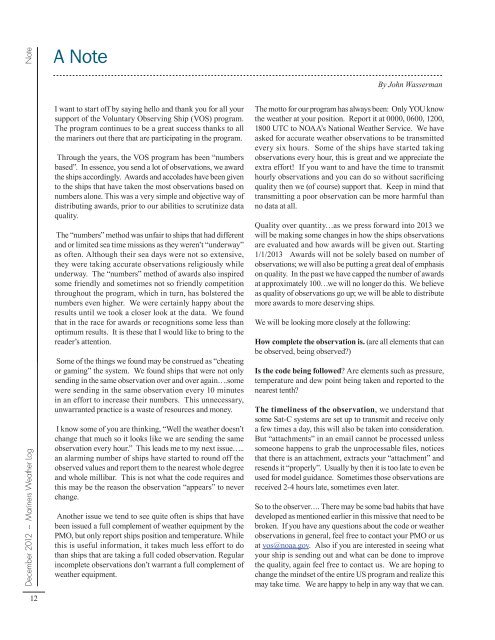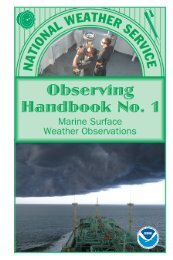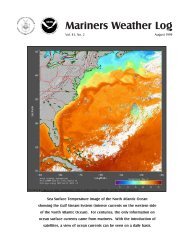Volume 56, Number 3 December 2012 Photo by Denice Drass
Volume 56, Number 3 December 2012 Photo by Denice Drass
Volume 56, Number 3 December 2012 Photo by Denice Drass
You also want an ePaper? Increase the reach of your titles
YUMPU automatically turns print PDFs into web optimized ePapers that Google loves.
Note<br />
<strong>December</strong> <strong>2012</strong> ~ Mariners Weather Log<br />
12<br />
A Note<br />
I want to start off <strong>by</strong> saying hello and thank you for all your<br />
support of the Voluntary Observing Ship (VOS) program.<br />
The program continues to be a great success thanks to all<br />
the mariners out there that are participating in the program.<br />
Through the years, the VOS program has been “numbers<br />
based”. In essence, you send a lot of observations, we award<br />
the ships accordingly. Awards and accolades have been given<br />
to the ships that have taken the most observations based on<br />
numbers alone. This was a very simple and objective way of<br />
distributing awards, prior to our abilities to scrutinize data<br />
quality.<br />
The “numbers” method was unfair to ships that had different<br />
and or limited sea time missions as they weren’t “underway”<br />
as often. Although their sea days were not so extensive,<br />
they were taking accurate observations religiously while<br />
underway. The “numbers” method of awards also inspired<br />
some friendly and sometimes not so friendly competition<br />
throughout the program, which in turn, has bolstered the<br />
numbers even higher. We were certainly happy about the<br />
results until we took a closer look at the data. We found<br />
that in the race for awards or recognitions some less than<br />
optimum results. It is these that I would like to bring to the<br />
reader’s attention.<br />
Some of the things we found may be construed as “cheating<br />
or gaming” the system. We found ships that were not only<br />
sending in the same observation over and over again….some<br />
were sending in the same observation every 10 minutes<br />
in an effort to increase their numbers. This unnecessary,<br />
unwarranted practice is a waste of resources and money.<br />
I know some of you are thinking, “Well the weather doesn’t<br />
change that much so it looks like we are sending the same<br />
observation every hour.” This leads me to my next issue…..<br />
an alarming number of ships have started to round off the<br />
observed values and report them to the nearest whole degree<br />
and whole millibar. This is not what the code requires and<br />
this may be the reason the observation “appears” to never<br />
change.<br />
Another issue we tend to see quite often is ships that have<br />
been issued a full complement of weather equipment <strong>by</strong> the<br />
PMO, but only report ships position and temperature. While<br />
this is useful information, it takes much less effort to do<br />
than ships that are taking a full coded observation. Regular<br />
incomplete observations don’t warrant a full complement of<br />
weather equipment.<br />
By John Wasserman<br />
The motto for our program has always been: Only YOU know<br />
the weather at your position. Report it at 0000, 0600, 1200,<br />
1800 UTC to NOAA’s National Weather Service. We have<br />
asked for accurate weather observations to be transmitted<br />
every six hours. Some of the ships have started taking<br />
observations every hour, this is great and we appreciate the<br />
extra effort! If you want to and have the time to transmit<br />
hourly observations and you can do so without sacrificing<br />
quality then we (of course) support that. Keep in mind that<br />
transmitting a poor observation can be more harmful than<br />
no data at all.<br />
Quality over quantity…as we press forward into 2013 we<br />
will be making some changes in how the ships observations<br />
are evaluated and how awards will be given out. Starting<br />
1/1/2013 Awards will not be solely based on number of<br />
observations; we will also be putting a great deal of emphasis<br />
on quality. In the past we have capped the number of awards<br />
at approximately 100…we will no longer do this. We believe<br />
as quality of observations go up; we will be able to distribute<br />
more awards to more deserving ships.<br />
We will be looking more closely at the following:<br />
How complete the observation is. (are all elements that can<br />
be observed, being observed?)<br />
Is the code being followed? Are elements such as pressure,<br />
temperature and dew point being taken and reported to the<br />
nearest tenth?<br />
The timeliness of the observation, we understand that<br />
some Sat-C systems are set up to transmit and receive only<br />
a few times a day, this will also be taken into consideration.<br />
But “attachments” in an email cannot be processed unless<br />
someone happens to grab the unprocessable files, notices<br />
that there is an attachment, extracts your “attachment” and<br />
resends it “properly”. Usually <strong>by</strong> then it is too late to even be<br />
used for model guidance. Sometimes those observations are<br />
received 2-4 hours late, sometimes even later.<br />
So to the observer…. There may be some bad habits that have<br />
developed as mentioned earlier in this missive that need to be<br />
broken. If you have any questions about the code or weather<br />
observations in general, feel free to contact your PMO or us<br />
at vos@noaa.gov. Also if you are interested in seeing what<br />
your ship is sending out and what can be done to improve<br />
the quality, again feel free to contact us. We are hoping to<br />
change the mindset of the entire US program and realize this<br />
may take time. We are happy to help in any way that we can.






